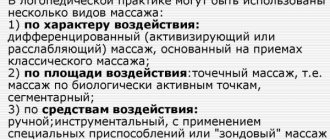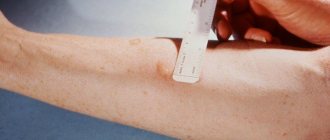Is the baby developing correctly, is everything fine, is there any cause for concern?
One of the significant moments that indicates smooth, good development is the ability to raise and hold your head.
Both too early and late development of this skill is a reason to consult a neurologist. At what age is this considered normal?
Types of strengthening massage
Options for back massage for children are classified depending on the area of the tasks, which are supposed to be solved through the use of manual techniques.
There are therapeutic, corrective, and preventive types. At the same time, it is recommended to entrust the implementation of the first two options only to a specialist, since such techniques are used exclusively to eliminate existing problems.
As for preventive massage of the back and spine, you can perform it yourself at home, since this type of manipulation does not require special skills. Its main goal is to strengthen the back muscles, stimulate blood flow, and increase body tone.
Massage for hypertension
The duration and systematicity of massage courses is determined in accordance with the age characteristics of the baby. It is recommended to give a back massage to a one-month-old baby for ten days. The best option would be to conduct the course once within three months.
Massage to strengthen the back of a child 6 months or more can be done more often - a course of preventive manipulations can be carried out once a month.
As for back massage for newborns, in this case light strokes can be performed daily, and one procedure should not last more than two to three minutes.
As already emphasized above, you can perform a restorative back massage for preventive purposes on your own.
Moreover, this kind of procedure will help establish stronger physical and emotional contact between the baby and the parents. It is important to remember that massage techniques should not cause pain or discomfort to the baby.
If you find an error, please highlight a piece of text and press Ctrl Enter. We will definitely fix it, and you will suffer karma
Experts advise giving a massage to a baby at 3, 6, 9, 12 months (a course of 10 procedures). Why so often? The fact is that it is precisely at the age of up to one year that massage and gymnastics determine when and how the child begins to sit up, crawl, and walk. In addition, mother’s touch perfectly calms and puts you in a positive mood...
It is advisable to massage a toddler in the first half of the day (about an hour after feeding or 40 - 60 minutes before it).
Up to three months in infants, the flexor muscles of the limbs are in good shape. This is fine. Gradually the muscles learn to straighten and the hypertonicity goes away. Children with hypotension cannot tense the muscles of their arms and legs.
Sometimes such muscle relaxation is associated with a genetic disease - Down syndrome. The cause may also be birth trauma, during which the muscles receive an insufficient amount of oxygen, which is associated with impaired blood supply. But the most common cause of muscle weakness is the baby’s low weight.
For hypertonicity, start the massage by stroking your arms and legs. Next - rubbing in a circular motion. Place the baby on your stomach and your hand along the baby's back. Without lifting your hands from his back, gently move his skin up, down, right and left with line movements.
Turn the baby over on his back, take his hand and shake it lightly, holding the baby by the forearm 2-3 times. Perform massage techniques on the arms and legs. Grasp the baby's arms above the wrist and, with quick, gentle movements, swing and shake them from side to side. Your movements should be rhythmic without jerking. Be sure to do some stroking after this exercise.
Baby massage
Your goal is to strengthen your muscles. Start the massage with the legs. Then move on to the back and tummy, and only then massage the baby’s arms and head.
The difference between massage for hypotension is that warming procedures are carried out before the session. You can warm the diaper with an iron and wrap the baby’s limb for a while. You can also warm it up with paraffin applications. But this should only be done as prescribed by a pediatrician.
Start and end the massage of the part of the body you are working on with light strokes. All movements must correspond to the course of the lymph (from the heels to the butt, from the lower back to the neck, from the hand to the shoulder girdle).
You can perform rubbing with strokes. If your baby is under 3 months old, perform this technique with only one finger. For older children, the technique can be performed with two fingers. With intermittent movements you can “draw” lines on the skin. When performing the technique, move 1 cm each time.
You can perform rubbing with the edges of your palms, using sawing movements. One hand should move forward, while the other should go in the opposite direction. Perform these movements on the legs, back and arms of the toddler.
Once you’ve prepared your baby’s skin, move on to deep techniques that work on the muscles. In order to adjust the force of pressing on the muscles, practice on yourself. Don't forget to lubricate your hands with oil or baby milk.
We suggest you read: Exercises for the back with a hernia of the lumbar spine
You can do the move with weights. Your task while performing this technique is to slightly increase the load on the child’s muscles. Place one hand on top of the other and slowly move along the baby's skin until a small roll of skin forms in front of your hands.
Perform a foot massage. They are very closely related to the child’s muscular system. Therefore, do not spare time for them. Perform rotational movements very carefully. Note! This technique is unacceptable for premature babies!
You can perform light pinching. Grab your baby's skin lightly into the fold and release. Do this along the massage lines. Over time, you will learn to perform this technique continuously, as if rolling a fold of skin between your fingers. Make sure that the reception does not cause pain in the child.
Let's consider options specifically for mothers.
1. When does a child hold his head independently while lying on his stomach?
As a rule, normal raising of the head from a lying position on the stomach begins to occur at the age of 2 months, plus or minus a week. At first, these are short-term attempts to keep his head raised, but gradually the newborn begins to hold his head more confidently, without swaying and dangling.
Also, the time the head is held gradually increases. During this period, cervical lordosis (physiological forward bending of the spine) is formed. The child needs to create conditions for such “training” and do not forget to lay the baby on his stomach several times a day on a moderately hard surface (a table with a thin blanket). Often babies are late in raising their heads and restless mothers sound the alarm, but it also happens that they wait up to 4 months for “sea weather”, this is also not good. If your baby doesn’t even think about trying to lift his head at 2 months, lay him on his stomach more often and you shouldn’t pick him up at the first sound of displeasure from the baby, let him struggle and grunt. If at 3 months the head lies down and does not rise, then you should call a massage therapist and do not hesitate. And there’s no point in talking about later dates; a massage with exercises for the neck should fix everything.
2. When does a child begin to hold his head up on his own, pulling himself up by his arms?
This option is a little more complicated than the previous one. Those. achieving results is more difficult and takes longer for both the specialist and the child, and mother’s massage is generally inappropriate. But this is true if we consider the complete absence of tension in the flexors of the head and neck, and visible attempts to pull the head forward, following the arms. Let me remind you that this is an option when the child lies on his back and with traction (tension) by the arms, the body rises following the arms, and the head hangs. Normally, the head/neck should be in line with the body or even slightly bent forward, with the chin touching the chest. The child needs this skill in order to confidently hold his head in an upright position and to roll onto his stomach. The muscles that carry out this holding/bending of the head are needed in order to inhibit hyperextension or falling of the head back; they stabilize its position. At the age of 3 months, children should usually be able to pull themselves up by their arms while holding their head, at least for a short time.
Strengthening the head flexors in newborns is not an easy process, requiring knowledge, understanding of what to do and in what order, etc. Mothers can do back-to-stomach rollovers with their baby as homework, because... at the moment the baby turns from back to side, these muscles are partially included in the process. For the rest, you need to call a specialist in children's massage.
Contraindications to massage
There are a number of contraindications, the presence of which precludes the possibility of giving a child a back massage. Among them:
- large hernias.
- Epilepsy.
- Rickets is in the acute stage.
- Diseases associated with hemolymph coagulation disorders.
- Increased body temperature due to infectious diseases.
- Dermatological diseases, open wounds, pustular lesions of the skin.
- Heart defects.
- Disruption of circulatory processes.
In what cases is massage for infants contraindicated?
- Presence of diaper rash, atopic dermatitis and other irritations on the skin;
- runny nose, ARVI, fever - during illness, infants are very capricious and need rest, so you should refrain from massage until recovery;
- colic, teething period.
If infants are diagnosed with heart disease, rickets, umbilical hernia, hip dysplasia, or pathologies of the central nervous system, a special technique is required. Your doctor will tell you and show you how to massage correctly so as not to harm your baby.

Nuances
Always start the complex with light stroking. If possible, buy a fitball. Place the baby on it with its tummy and holding it by the hands. Download it. Alternate exercises on the ball and standard massage. Never carry out the procedure if the baby is in a bad mood.
The younger your little one, the more gentle the touches on his body should be. Stroking the legs, back, tummy (clockwise!), and chest. Spend a little time on each part of the body, do it 3-4 times. Be sure to prepare your hands. Do not massage with cold, wet hands and jewelry. Long nails and finger jewelry can damage delicate skin. For a gliding effect, lubricate your hands with baby oil.
Does your baby have hypertension? Then add rubbing to the stroking movements. Perform sawing with the edges of the hands. Do not work on your elbows, knees or chest glands. Do not touch these parts of the baby's body.
The baby is already ready for deeper massage techniques. After you have prepared the child's body with stroking and rubbing techniques, perform the kneading technique with your knuckles. While performing the techniques, make sure that the baby does not experience discomfort. If you did everything correctly, then deep techniques will not cause the toddler’s indignation. Try tingling. But first, test this technique on yourself to understand with what force to influence.
Now your little one is ready for light striking techniques. Introduce patting with your palm or fingertips into your massage session. Do not work on the projection areas of the kidneys and heart. The technique must be combined with stroking.
How long does the session last?
The duration directly depends on the age of the children and their emotional mood. For children under 6 months, it is advisable to do 15 to 20 minutes a day. If the procedure is carried out by a professional, then the first session is short, since the massage therapist must first establish contact with the baby. It is important that during the session he experiences joyful emotions.
- The duration of the session for infants from 6 to 12 months increases to 30 minutes.
- Children from 1 to 3 years old undergo a session of 30 to 40 minutes.
The course of procedures lasts from 10 to 15 days. But if the baby feels unwell or is in a bad mood, the session can be skipped and repeated the next day.
Simple gymnastic exercises are added to massage for young children.
Main rules
The technique of performing a back massage for a child is more than simple; anyone can master it.
However, before you begin the procedure, it is important to familiarize yourself with several important rules:
- It is recommended to start the first sessions no earlier than when the child reaches two weeks of age.
- It is not recommended to conduct a session early in the morning or late in the evening; such a measure can have a negative effect on the general well-being of the child.
- The room should be warm, but high temperatures should also be avoided. The optimal thermometer value is no more than twenty-five degrees.
- Before carrying out the procedures, it is recommended to consult a doctor for possible contraindications and restrictions.
- You should not feed your child immediately before the session, or after it is completed.
- Despite the fact that the main goal of massage is to strengthen the back muscles, it is important to turn daily procedures into play and pleasure for the child.
- It is recommended to choose exercise options based on the child’s age.
- It is recommended to conduct the session in the first half of the day.
- If the child is capricious, hungry or sick, it is recommended to postpone the massage procedure.
You should massage your child's back carefully, avoiding sudden movements, otherwise achieving a positive result will be extremely problematic.
Features of the technology
When giving a child a back and lower back massage, it is important to pay attention to some features of the technique of the treatment procedure and the general sequence of actions.
If light strokes on the back are enough for a baby under six months of age, then older children are recommended to have a complex massage consisting of several stages.
They are as follows:
- First of all, you should prepare the baby’s skin and muscle tissue for the procedure. To do this, it is recommended to lightly stroke the baby's back for several minutes.
- To strengthen the back muscles, it is necessary to use methods such as rubbing and kneading.
- During the procedure, manipulation should be focused exclusively on the back muscles. It is highly not recommended to impact the child’s spine.
- To provide a general strengthening effect, it is recommended to massage not only the back, but also the baby’s arms and legs. To do this, you need to put the baby on his tummy and start with light stroking of the feet and palms.
- Regardless of the number of exercises and elements in the complex, each session should be completed by lightly stroking the child’s back.
We invite you to read: Gymnastics for a herniated cervical spine Dikul: exercises for treatment, Dikul method
A back massage will strengthen the child only if it is carried out in accordance with the above recommendations. Failure to follow basic rules can lead to negative consequences for the baby.
Place your baby on his back on the changing table. Place your hands on the baby's tummy on either side of the navel. The base of the palm should be on the baby's pubis. Using your fingertips, slowly stroke from left to right (clockwise). If you do this exercise not only in the morning, but also in the evening, your baby will definitely not have colic.
Is the toddler being capricious? Stroke him, hold him close to you, speak gently and... try this exercise, and if it doesn’t help, stop the massage temporarily (perhaps you inadvertently hurt him). Gently stroke your baby's back along the spine. It's relaxing.
Firming massage
Very soon the baby will stand on its legs, which means they need to be strengthened. Hold your baby's ankle and move from the foot to the knee, and then slowly work your way up to the hip. Now do the same with the other leg of the little one. Then you can pedal the invisible bicycle.
Baby massage
Strengthening the back
Regularly, before giving breastfeeding or a bottle of formula, place the baby on his tummy (on a fitball or hard surface) - this will strengthen the back muscles. Also, when the baby is in this position, give him a light massage.
First, walk along the back with your fingertips, then tap with the edges of your palms. In this case, the movements of your hands should be directed from the spine to the sides. Alternate light pats with stroking and tapping. Finish the exercise with light stroking.
Take the baby's hand and stretch each finger, each phalanx with light movements. Do the same with the second hand. Gently take the little one's palm and work with it. Draw initials with your finger on your palm or draw geometric shapes. Move to your wrist. Make light movements in the joints: flexion and extension. Massage will help develop finger dexterity. And your baby’s mental development and physical activity will depend on this.
Follow these steps. Warm up the back surface of the baby's hand. To do this, rub with light movements several times. Before massaging the hand, you can prepare the entire hand by lightly stroking it and rubbing it. This will make the massage even more effective.
Run the pad of your finger over each finger from its base to the wrist. Knead your finger like this: grab the finger between your fingers and perform a spiral movement from tip to base. On your big toe, pay attention to the pad. You can lightly tickle the baby's palm at the end of the massage session.
Stroke the baby's head in a circular motion. Run your fingers from the top of your head to the back of your head, and then to your forehead. Now walk from the middle of the forehead to the temples, then from the eyebrows to the scalp. You can gently draw from the nose to the temples, from the corner of the mouth to the tragus of the ear.
General strengthening techniques and exercises
To achieve only positive results, it is important to learn how to properly massage a child’s back, eliminating the possibility of causing discomfort and unpleasant sensations to the baby.
To carry out the procedure at home, it is enough to master several massage techniques that will help strengthen the baby’s muscles and stimulate blood circulation.
- Stroking. It is recommended to start the procedure with light strokes. This method will help warm up the baby's skin, improve the flow of hemolymph to the tissues, and strengthen the back muscles. In addition, light stroking will help calm the baby and improve his sleep. Movements should be as soft and gentle as possible. To prevent skin displacement, it is recommended to pre-treat your hands with massage oil or baby cream, which will help facilitate the sliding of your palms over the skin.
- Trituration. This massage option is a more intense stroking, involving the active influence of the palms on the baby's skin. Rubbing has effective warming properties, has a calming effect, stimulates blood flow, and strengthens back muscle tissue. It is permissible to rub any part of the baby’s body, but you should also remember that the procedure can only be carried out on a child whose age is more than three months.
- Kneading. One of the most effective and efficient techniques for providing a strengthening and warming effect. The only disadvantage of kneading is that this method can be used no earlier than after the baby is five months old. To knead the baby's skin, it is recommended to apply light, targeted pressure to individual areas with the pads of your fingers. To capture a larger area of skin, you can knead the child’s back using not only your fingers, but also your palms.
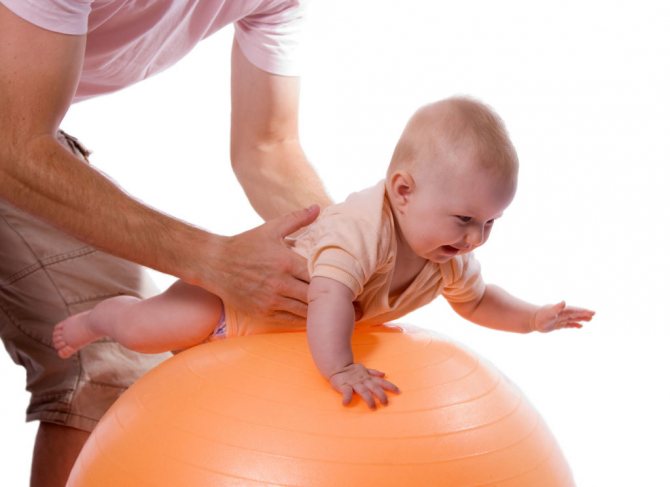
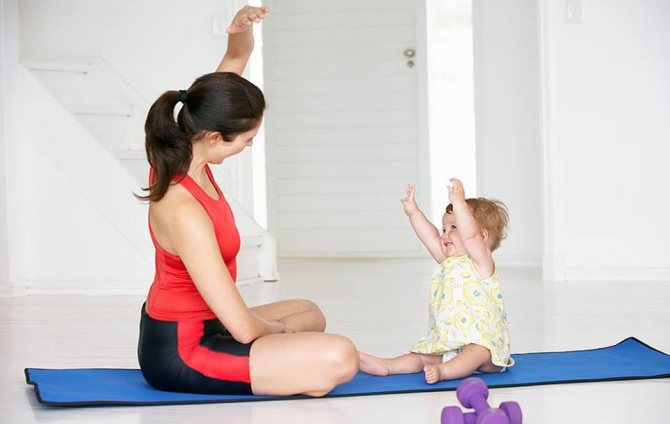
To provide a general strengthening effect, you can use additional exercises, for example, massaging the child’s back with a large ball - a fitball. To carry out the procedure, it is recommended to place the baby on the ball, gently holding it by the legs, and rock it slightly.
Exercises should be done daily, when the baby is in a good mood, has had enough sleep, and not earlier than 40 minutes after eating. It is recommended to repeat each exercise 3-5 times at first, and up to 10 as you become more trained.
- Famous tilts. They are useful not only for adults, but also for children; it’s just that the latter perform them with the help of the former. Place the baby in front of you, press his back to you, and clasp his hips with one hand. Bend over together, using your other hand to help your child straighten up. Subsequently, with this second hand you will only belay him, and the baby will straighten the body himself. You can do the same exercise in front of the table: placing the child’s heels on the table, clasping his knees and hips with one hand and pressing him to you, with the other helping him to bend and unbend.
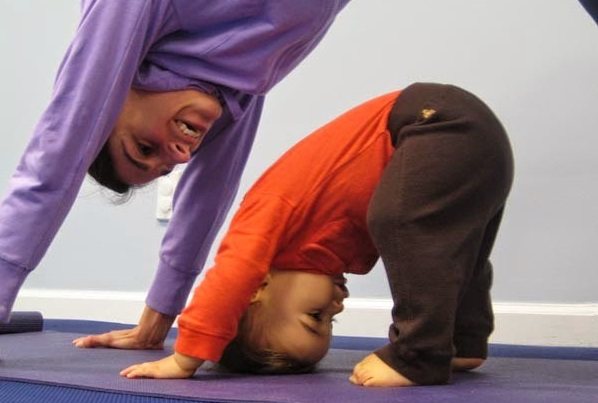
- Fitball exercises. Place the child with his tummy on the ball, with his feet towards you. Holding it by the armpits, roll it on the ball in different directions: away from you and towards you, in a circle clockwise and counterclockwise. Freeze for a few seconds from time to time so that the baby adapts to the new position. It’s good when the baby, lying on the ball, learns to arch his back with a boat. This means he is ready for the next exercise.
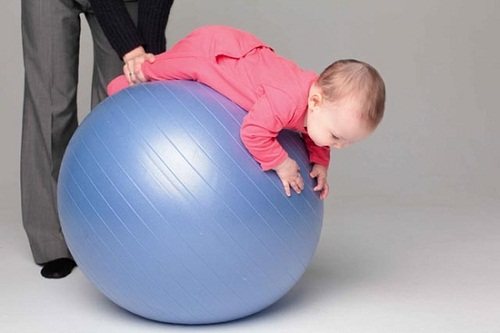
- We do the same, but hold the baby not by the armpits, but at hip level. Then it will be much more difficult for him to keep his back straight. Roll the ball away from you, hold for a few seconds and return to its original position so that the baby can rest.
- Running up the stairs. This exercise is suitable for children who have fully mastered the skill of crawling. Crawling up stairs is a great workout for your back and abdominal muscles. But, unfortunately, not every family in our country has a house with several floors and stairs. And you probably don’t want your child crawling along the common stairs of an apartment building. And he doesn’t need so many steps. Two or three are enough. For example, fold heavy hardcover books so that a ladder of 2 steps is formed leading to the bed (sofa). Place the baby on all fours in front of such a ladder and first move his knees and hands, helping him climb. After several attempts, the baby will understand what the essence of the game is and will climb on his own. Teach him to also go down the stairs backwards - just repeat the same steps, but in reverse order.
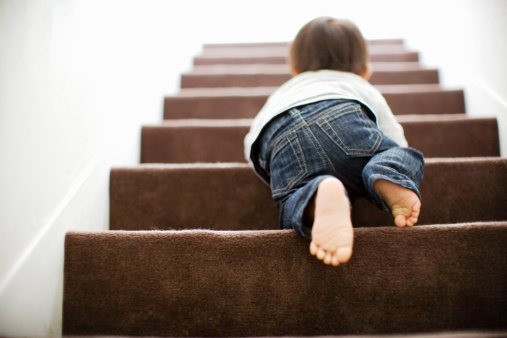
- Let's pull and pull. Place the little one across your lap. The goal of this exercise is to make the baby stretch with all his might. To do this, let's use a trick - in front of the child's eyes at a distance of a very outstretched arm - so that it is barely within reach - put the baby's favorite toys. As soon as he grabs one, start luring him with another, and so on several times. But do not snatch his “trophy” from the child’s hands - this will discourage any desire to play with you.
And, of course, it’s good if you take up infant swimming and your child knows how to row in the water. These movements are very beneficial for the back muscles, and do not overload the spine itself.
READ ALSO: Breast swimming
We suggest you read: X-ray of the knee joint – what does the image show?
Have you remembered everything and are full of inspiration to start training right away? Good luck, just don’t overload your baby and remember: all your actions, including strengthening exercises, are second-order phenomena. We repeat again, the child will learn to sit and walk when he is destined to. And you shouldn’t rush time so much - infancy is so fleeting that you will still be nostalgic for this period in your life.
When does a child hold his head upright?
Children begin to hold their heads upright from 2.5-3 months, but in the initial stages, support with the mother’s hand is mandatory. Hanging and head nodding in newborns at the beginning of verticalization of the body is common, and during this period (2.5-3 months) the baby must be protected from sharp, awkward head nods. In order for the child to quickly master the vertical position of the head, he should be carried in his arms more often, giving the head the opportunity to move in small amplitudes; the mother’s hand should belay, and not hold, the baby’s head. Norm. When do children hold their heads up on their own?
So let’s summarize when a child should hold his head up on his own. Lying on his stomach at 2 months, pulling himself up by the arms at 3 months, upright at 2.5-3 months. Delays in these terms of up to 2 weeks are tolerable, but if more, it is better to take action, because the ability/ability to hold the head in different positions allows the child to develop further unhindered. This is one of the most important steps in the development of every baby, and you shouldn’t wait until 5-6 months and then expect a 10-day massage course to immediately catch up on all the missed skills. After the emergence of each significant skill, time must pass for the child to master it well. Each movement has its own neural pathway from muscle fibers to the part of the brain responsible for the functioning of a specific area of the body. So, at the moment when the child first tries to raise his head, this means that the path/chain has closed and impulses have flowed along it from the muscle to the brain and back.
But this chain is still very thin and includes few working (passing impulses) nerve fibers, and this path/chain becomes stronger the more it is used. Therefore, after the baby begins to make new movements, time must pass until the next new ones, and all this time the baby will periodically repeat his skills. This is how the entire nervous system of the newborn is gradually launched and differentiated.


